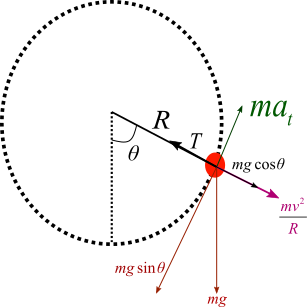
When a particle is moving in vertical circle,
A) Its radial and tangential acceleration both are constant
B) Its radial and tangential acceleration both are varying
C) Its radial acceleration is constant but tangential acceleration is varying
D) Its radial acceleration is varying but tangential acceleration is constant
Answer
216.9k+ views
Hint: To this thing we assume a particle which is moving in vertical circular path when any object moving in vertical circular path then it has both type of acceleration radial acceleration as well as tangential acceleration by the radial acceleration object change its direction regularly means it helps to maintain the motion in a circular path Which provided by the centripetal Force and tangential acceleration act along in tangential direction which manage the speed of object in path
Complete step by step solution:
Whenever object move in a vertical circular path then it has both type of acceleration
Let us assume the object of mass Moving in a vertical circular path with the help of a string when it moved in circular path centripetal force acts on it to maintain its circular path

As you can see in the diagram at any instant the object at point B at this moment the force on the object mentioned in the above diagram.
From this diagram we can write following equations
Balancing force in radial direction
$ \Rightarrow mg\cos \theta + \dfrac{{m{v^2}}}{R} = T$
$ \Rightarrow \dfrac{{m{v^2}}}{R} = T - mg\cos \theta $
Here $\dfrac{{{v^2}}}{R}$ Is the centripetal acceleration toward the centre which is also known as radial acceleration ${a_R}$
From above equation Radial acceleration${a_R}$
$\therefore {a_R} = \dfrac{{T - mg\cos \theta }}{m}$ ................... (1)
From this equation we can see that radial acceleration depends upon angle $\theta $ which is varying so radial acceleration varies in vertical circular motion.
For tangential force
$ \Rightarrow m{a_t} = mg\sin \theta $
So tangential acceleration ${a_t}$
$\therefore {a_t} = g\sin \theta $
So we can see from this equation tangential acceleration also depends upon angle $\theta $ so tangential acceleration is also varying in vertical circular motion.
Hence option B is correct.
Note: We know best speed of object moving in vertical circular path gradually decreases when it move from lowest most point to the top most point and the speed of object gradually increases when object move top most point to the lowermost point it means the magnitude off velocity of object continuously change in vertical motion.
Complete step by step solution:
Whenever object move in a vertical circular path then it has both type of acceleration
Let us assume the object of mass Moving in a vertical circular path with the help of a string when it moved in circular path centripetal force acts on it to maintain its circular path

As you can see in the diagram at any instant the object at point B at this moment the force on the object mentioned in the above diagram.
From this diagram we can write following equations
Balancing force in radial direction
$ \Rightarrow mg\cos \theta + \dfrac{{m{v^2}}}{R} = T$
$ \Rightarrow \dfrac{{m{v^2}}}{R} = T - mg\cos \theta $
Here $\dfrac{{{v^2}}}{R}$ Is the centripetal acceleration toward the centre which is also known as radial acceleration ${a_R}$
From above equation Radial acceleration${a_R}$
$\therefore {a_R} = \dfrac{{T - mg\cos \theta }}{m}$ ................... (1)
From this equation we can see that radial acceleration depends upon angle $\theta $ which is varying so radial acceleration varies in vertical circular motion.
For tangential force
$ \Rightarrow m{a_t} = mg\sin \theta $
So tangential acceleration ${a_t}$
$\therefore {a_t} = g\sin \theta $
So we can see from this equation tangential acceleration also depends upon angle $\theta $ so tangential acceleration is also varying in vertical circular motion.
Hence option B is correct.
Note: We know best speed of object moving in vertical circular path gradually decreases when it move from lowest most point to the top most point and the speed of object gradually increases when object move top most point to the lowermost point it means the magnitude off velocity of object continuously change in vertical motion.
Recently Updated Pages
Introduction to Dimensions: Understanding the Basics

[Awaiting the three content sources: Ask AI Response, Competitor 1 Content, and Competitor 2 Content. Please provide those to continue with the analysis and optimization.]

JEE Atomic Structure and Chemical Bonding important Concepts and Tips

JEE Amino Acids and Peptides Important Concepts and Tips for Exam Preparation

Electricity and Magnetism Explained: Key Concepts & Applications

Chemical Properties of Hydrogen - Important Concepts for JEE Exam Preparation

Trending doubts
JEE Main 2026: Application Form Open, Exam Dates, Syllabus, Eligibility & Question Papers

Derivation of Equation of Trajectory Explained for Students

Hybridisation in Chemistry – Concept, Types & Applications

Understanding the Angle of Deviation in a Prism

Understanding Collisions: Types and Examples for Students

How to Convert a Galvanometer into an Ammeter or Voltmeter

Other Pages
JEE Advanced Marks vs Ranks 2025: Understanding Category-wise Qualifying Marks and Previous Year Cut-offs

Units And Measurements Class 11 Physics Chapter 1 CBSE Notes - 2025-26

NCERT Solutions For Class 11 Physics Chapter 8 Mechanical Properties Of Solids

Motion in a Straight Line Class 11 Physics Chapter 2 CBSE Notes - 2025-26

NCERT Solutions for Class 11 Physics Chapter 7 Gravitation 2025-26

Understanding Atomic Structure for Beginners




